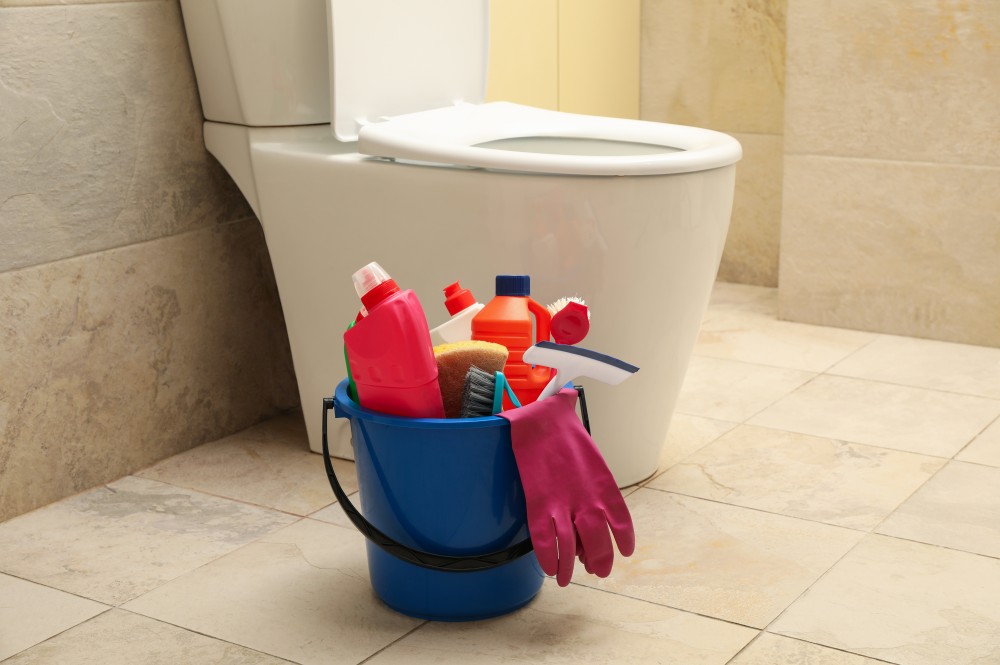- Empty cart.
- Continue Shopping
Prevent & Remove Rust Stains from Your Toilet Bowl Effortlessly

Rust stains in your toilet bowl are more than simply an eyesore — they can create the appearance of neglect and unhygienic practices even if the rest of your bathroom is spotless. Rust stains in the toilet bowl are often hard to get rid of and, once settled in, can be a consistent issue if not dealt with appropriately. Whether you are a homeowner or work as a professional cleaner, knowing how to prevent and/or get rid of rust stains in a toilet bowl may be an important part of maintaining a clean and fresh bathroom.
In this blog, we’ll explore the causes, prevention methods, and effective solutions, including how a descaler rust remover can be a game-changer in your cleaning routine.
Understanding the Causes of Rust Stains
Before we start discussing removal techniques, it is important to understand what causes rust stains in the first place. Typically, the reddish-brown stains you are noticing in the toilet bowl are caused by iron in your water source. When iron is exposed to both oxygen and moisture, an oxidation reaction happens and forms rust. This rust sticks to the porcelain surface of your toilet bowl and creates those rusty stains you are finding in your bowl.
Rust stains are capable of forming even if you clean your bathrooms often. The issue is often not due to cleaning effectively or at all, but rather than once again there is high iron content in the water itself or in corroding pipes and fixtures.
Common Sources of Rust Stains:
- Hard water with high iron content
- Old iron pipes that are corroding
- Metal components inside the toilet tank
- Well water systems lacking filtration
Why Traditional Cleaners Don’t Work
It may be tempting to use your regular bathroom cleaner to wipe away rust stains, but you’ll likely find that they won’t come off entirely. This is primarily because rust is a chemical stain that bonds to surfaces quite strongly. Bathroom cleaners generally are made to remove soap scum, filth, and dirt but mineral deposits and rust are different and require specific cleaning products to treat them effectively.
Essentially, rust removers and descaling products are made with acidic ingredients to chemically break down the iron oxide rather than physical means. This is why removing rust stains from your bathroom is a lot more effective than just using bleach applied to scrubbing!
Step-by-Step Guide to Removing Rust Stains
Let’s walk through a comprehensive method to remove rust stains from your toilet bowl efficiently. You don’t need to be a professional cleaner — just follow these steps.
- Turn off the Water Supply
First, shut off the water valve at the base of your toilet before you begin treatment. Flush the toilet, which will remove most water from the bowl, allowing you to not only see the stain’s extent, but also give you better access to the surface you’re applying the product to.
- Dry the Bowl
Take a sponge or cloth and soak up any residual water. This will allow the cleaning solution to better adhere to the surface, which should provide a more powerful, focused effect whenever diluted fluid is removed.
- Apply a Descaler Rust Remover
Simply choose a bathroom-safe high-quality descaler rust remover. Generously apply to the area and let the product sit for 10-15 minutes to allow the acids to dissolve the iron oxide rust at the molecular level.
Important: Always wear gloves and ensure the room is well-ventilated when using chemical cleaners.
- Scrub Gently with a Toilet Brush
After the cleaner has done its job for a bit, use the toilet brush or a non-abrasive scrub pad to scrub at the stained areas. Most of the rust should come off without too much trouble at this point. It’s best not to use metal brushes because they might scratch the porcelain and make the stains harder to get off in the future.
- Flush and Rinse Thoroughly
Once you are done scrubbing, turn the water back on, flush the toilet, and rinse away the cleaner and any residue. You should have noticed an improvement or complete removal of the rust stains.
Natural Alternatives (If You Prefer a DIY Route)
If you want to try something more natural, there are some home remedies that will work but will likely take more effort and might need more than one application to get the desired results.
Baking Soda and Vinegar
Make a paste using baking soda and vinegar and apply to stains. Let it sit for about 30 minutes to an hour, and then scrub the area with a brush. While the fizzing action will help break down the rust, it probably won’t be as effective as a descaler rust remover.
Lemon Juice and Salt
You can also use lemon juice, which is mildly acidic, meaning it can help to dissolve rust. Sprinkle some salt over the stained area and pour lemon juice over the top. Let it sit for a while and then scrub the area clean.
Pumice Stone
A pumice stone is effective for stubborn stains, but take care. Wet both the stone and the bowl first. Don’t scratch the surface.
Preventing Rust Stains from Coming Back
After you have accomplished the removal of stains, your next goal is prevention. Preventing rust staining involves cleaning, treating the water, and a few plumbing or fixture upgrades.
- Install a Water Softener or Iron Filter
If rust stains are a chronic issue, you might need to consider treating the source of the problem, your water. Water softener or whole-house iron filter systems will significantly lower the iron content of the water and ensure future staining does not happen.
- Upgrade to Non-Metallic Toilet Parts
Look at the internal elements of the toilet tank. Older toilets may have metal bolts and washers that can corrode, leading to rust stains. Replace metal parts with plastic or even stainless steel to reduce the amount of rust inside, preventing it from ending up in the bowl.
- Clean Regularly with Mild Acids
Using mild acidic cleaners, such as vinegar or citric acid regularly can help to prevent any mineral buildup from becoming entrenched. This can keep small rust stains small and not a bigger issue later.
- Use Toilet Cleaning Tablets Wisely
here are toilet tablets that say they will help to prevent stains, but be careful. Tablets with bleach can speed up the corrosion of metal parts in the toilet tank. Use only toilet tablets that are safe for the internal components of the toilet and your goal.
When to Call a Professional
If you’ve tried everything and the stains persist, it may be time to call in a plumber or water treatment specialist. Persistent rust stains could be a sign of:
- Severely corroded pipes
- A malfunctioning water heater (which can release iron sediment)
- High levels of iron or manganese in your water source
A professional can test your water, inspect your plumbing, and recommend long-term solutions tailored to your situation.
Safe Cleaning Tips
Using chemical cleaners like a descaler rust remover can be very effective, but always remember the following safety tips:
- Never mix cleaning products (especially bleach with acids)
- Wear gloves and eye protection
- Ventilate the area
- Store cleaners out of children’s reach
- Follow label instructions exactly
Choosing the Right Descaler Rust Remover
How do you ascertain the best products to assist with your cleaning job, especially with so many options available on the market? You want the cleaner to effectively remove stains and to ensure it protects the porcelain or ceramic surface long-term.
- Designed specifically for rust and limescale
Choose a product specifically designed to dissolve both rust and limescale, as those two will often be the common stain culprits in the bathroom. Generic-style cleaners may not have the strength or purpose-formulated ingredients to break down iron oxide.
- Safe for porcelain surfaces
Be sure to choose a descaling agent that contains a rust remover that is marked safe for porcelain cleaning, to avoid scratching or dulling the shine of your toilet bowl finish; if you don’t use the right product you will damage the surface permanently over time.
- Non-toxic or eco-friendly options if preferred
Choose a product that is biodegradable or non-toxic, if you’re worried about using over-the-top chemical constituents. These types of porcelain toilet cleaner products are safer for your family, your pets, and the environment while still effectively removing rust.
- Fast-acting and easy to rinse
In addition, the best products should have you noticing results in minutes, and ultimately rinse away during cleaning without leaving residue; saving you time during your cleaning job, and not having to put in any extra effort.
Reviews of products and general trusted brands can also help with your decision process. As a high-quality descaler or rust remover should achieve results quickly, the benefit of all of this – is that you will only need a couple applications to maintain a good rinse in your toilet bowl with minimal effort.
Benefits of a Rust-Free Toilet
Keeping your toilet bowl rust-free isn’t just about aesthetics. There are practical benefits too:
- Improved hygiene and sanitation
- Extended lifespan of your toilet and plumbing
- A fresher-smelling bathroom
- Enhanced appearance, especially important for guest bathrooms or real estate staging
- Reduced need for harsh scrubbing and cleaning time
While rust stains may seem insignificant, they often come with concerns regarding cleanliness and comfort level. A clean and well-kept bathroom is an aspect of home upkeep.
If you enough to care about the environment, you may want to look for biodegradable products safe for septic systems. Some plant-based rust removers do its job with either citric acid or lactic acid, as opposed to any harsh chemicals.
And if you are using a natural product, sometimes you have to give it time to work and it might take a few different treatments, but in the end, you get gentler ingredients and the lower impact to our environment is worth it.
Conclusion
Rust stains in toilet bowls can be frustrating, stubborn, and unappealing. But with a little consideration and the right approach, rust doesn’t have to be an everyday sight in your bathroom. Whether you take the DIY approach, or splurge for a high performance descale rust remover, consistency of care and protection will result in a previously maintained, satisfactory result.
The most important thing is to act quickly when you see rust, stay ahead of it, do what you need to do to prevent it from returning, and use the right products. By following the steps mentioned above, you can easily remove rust stains while restoring your toilet back to its original white shine, without hiring a professional cleaner.
Clean bathroom, happy home!





